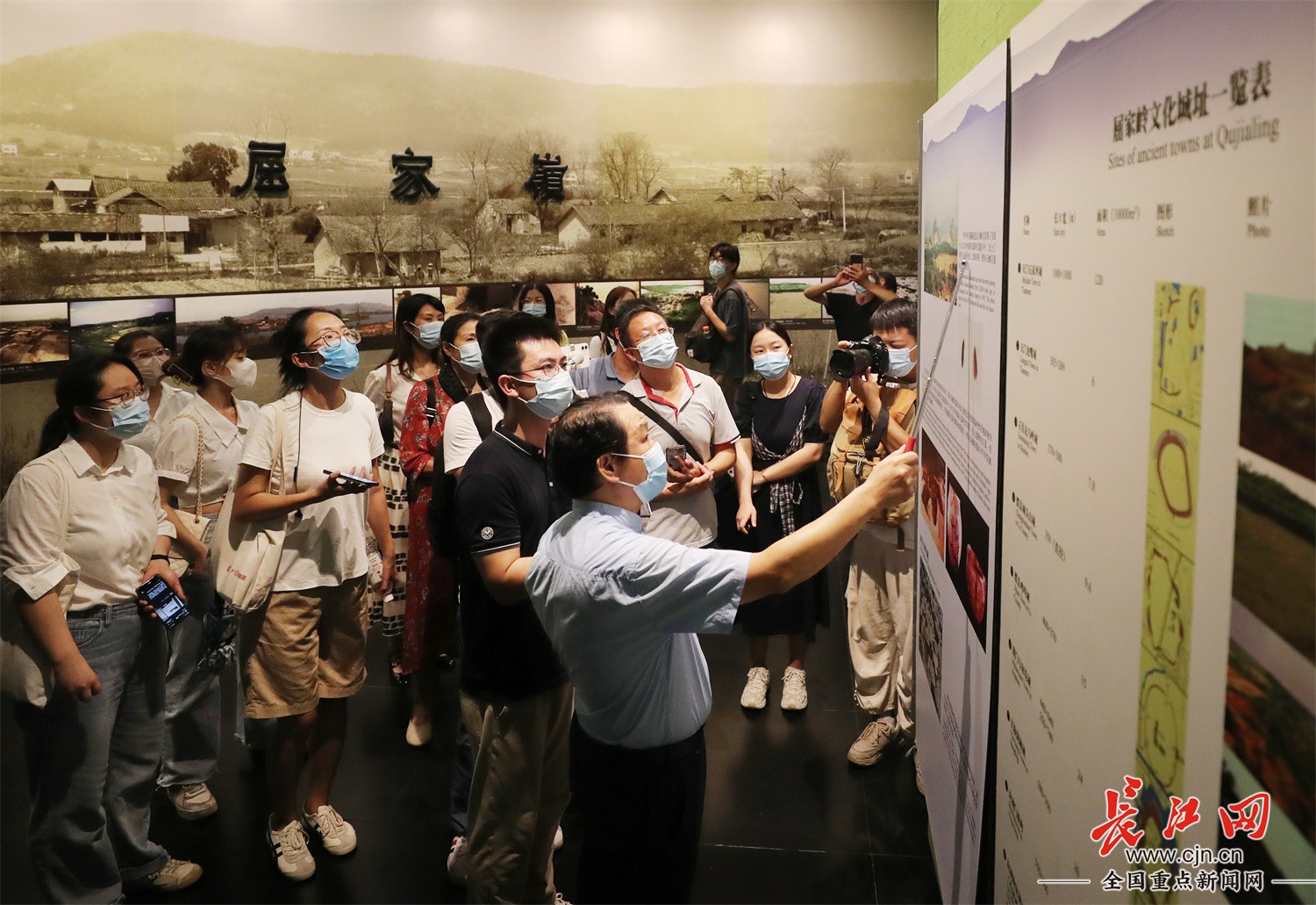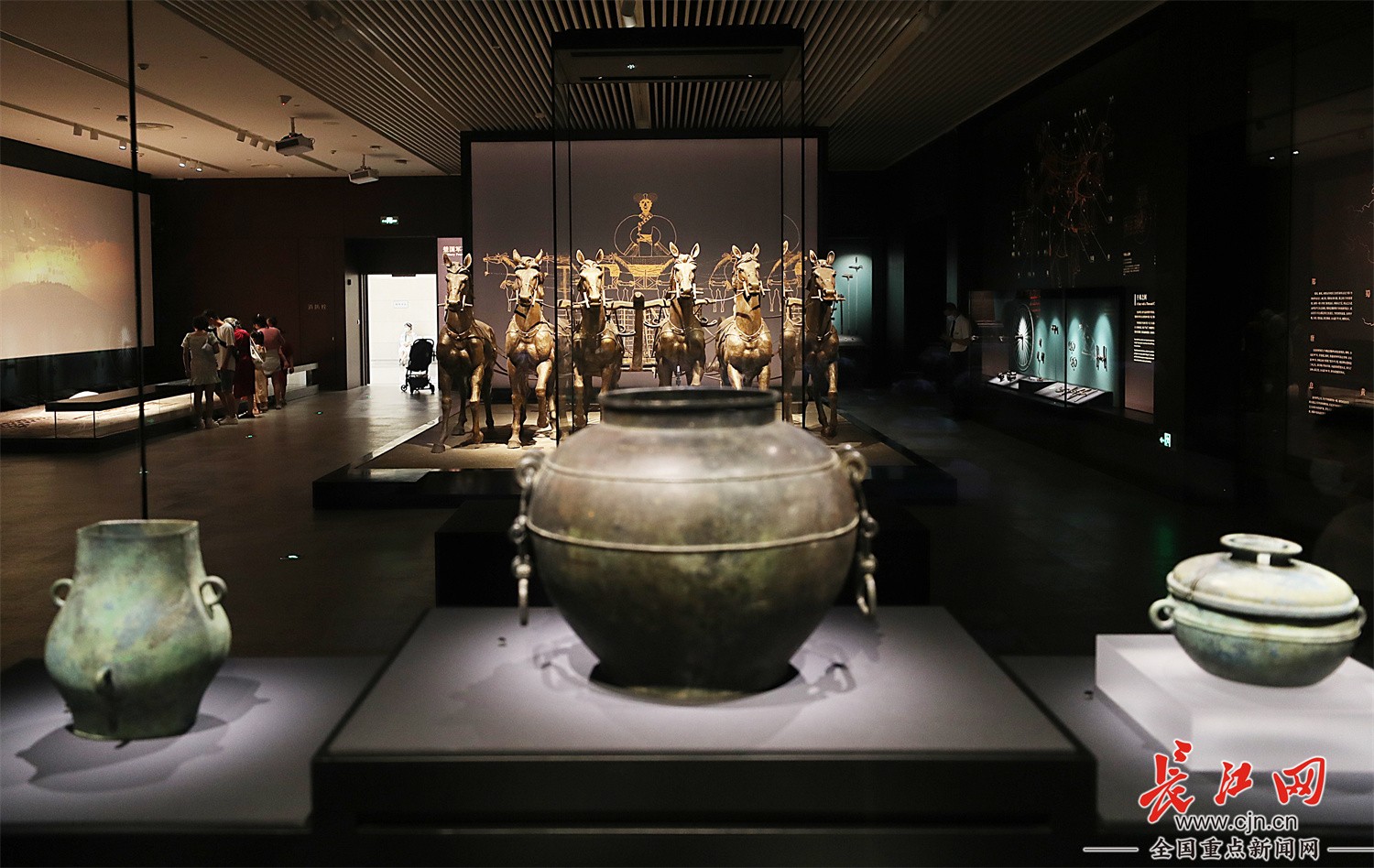Two million -year -old skulls are less than 300 meters apart. This discovery has global significance
Author:Yangtze River Time:2022.09.03

The members of the visit delegation visited the Hubei Provincial Museum under the leadership of Fang Qin. Changjiang Daily reporter Qiu Yan
The Yangtze River Daily-Yangtze River News (Reporter Li Jianhua Correspondent Zhang Yushan) "The source of the Jingchu culture is long and profound." On the night of August 26, "Reading China-Hubei Changjiang Thousand Miles along the Yangtze River" visiting group came to the Hubei Provincial Museum Visit the "Langxian People" exhibition hall, read the millions of human history, 10,000 years of cultural history, and more than 5,000 years of civilized history shown by Jingchu culture.
Two county -soul skull fossils are less than 300 meters apart.
When I walked into the Pixian Exhibition Hall, the members of the visiting group first saw the "Entrying Map of the Important Site of the Hubei Paleolithic Age". Fang Qin, the director of the Hubei Provincial Museum and the dean of the Hubei Provincial Cultural Relics and Archeology Research Institute, told the visit group that Hubei was my country. It is found that the most ancient human fossils have the largest number of areas, and the long span is long, indicating that Hubei is an important area for the origin of human beings.
Fang Qin introduced that the Giant Ape Cave in the Qingjiang River Basin, which was located in the Yangtze River, found that the teeth fossils of the beginning of the Shi Shi Shi and the contemporary mammalian fossils, as well as related sites and living environment. One of the earliest human relics (Chongqing Wushan people are also about 2 million years ago), which is of great value for exploring human origins.
Fang Qin pointed to the upper reaches of the largest tributaries in the Yangtze River that in the Xuexueliangzi of Xiyang County in Shiyan City, it was found that the site of the people of Yixian County was about 1 million years ago. Fossils, and obtained the number of mammal fossils with the same strata as the fossils of the Pianxian County, and stone tools such as hand picks, hand axes, and related living environments.

The "Luxian No. 1 Sluthards" at the Hubei Provincial Museum is the most intact -bone bone fossil in my country. Changjiang Daily reporter Qiu Yan
"On the same ground, it is less than 300 meters away. At the same time, it was found that two ancient human fossils were found in the history of archeological history." Fang Qin introduced that the period of the people in Lixian was evolved in the period of 1 million years before this million years. In the critical period, its discovery has deepened the study of the evolution of upright people in about 1 million years away from this year. It is extremely rare in the research of human origin in the world, especially for the "multi -regional evolution theory" of human origin of the origin of human beings, which has global significance.
Fang Qin further introduced that the upper reaches of the Hanjiang River with the people of the county were also about 750,000 years ago, about 750,000 years ago, the Meixian Meipu ape man, about 600,000 years ago, the Bailong Cave Ape man, and about 100,000 years ago. Fossils such as Huanglongdong Ape man, as well as the mammalian fossils and living environment information of the same period, are also of great significance to the research on human evolution.
"The middle and upper reaches of the Hanjiang River centered on the people in the county are the important areas of Chinese human evolution research. It can be called the human evolutionary corridor. "Fang Qin said.
The Changyang mast ping site has witnessed the origin of the Yangtze River's civilization of about 15,000 to 10,000 years ago
It is understood that the founder belongs to the early upright person, and the people of Dixian are late upright. After the upright person, it is a Homo sapiener. Homo sapiens have lived in about 200,000 years.
Fang Qin introduced that Hubei is an important area for ancient human reproduction and activities. Human fossils and relics discovered by archeological discovery show that almost all of the different stages of human evolution have left their footprints here. Essence
In 1956 and 1957, human upper jaw bones and a molars fossils were found in the dragon cave in Zhongjiawan, Changyang County, Hubei. Fang Qin said that it can be seen from the upper jaw orthopedic specimen that Changyang people are more progressive than Beijingers. It belongs to the early premium type, which is about 200,000 to 100,000 years ago. They are close to modern people and can make different stone tools.
In 1997, a cadre of Hannan District Mao Yongyuan collected a skull fossil in the Yangtze River Beach near Saomoshan, Wuhan, and was a 25-35-year-old female individual. Fang Qin said that Hannan District was originally Hanyang County, so it was named "Hanyang". "Hanyang people" belong to the late premium, about 20,000 years ago. In addition to the primitives of tools, they are similar to modern people, and they only retain very little primitive properties.

The Hanyang Museum's "Hanyang Head Covering Bone Fossils" exhibited. Changjiang Daily reporter Qiu Yan
Some members of the visiting delegation asked, as the ancient humans in Hubei became smarter, from the perspective of the relics, did their living standards get better and better?
Fang Qin replied that yes, many ancient human relics in Hubei showed their improvement of their living standards. Located near the Yangtze River dry stream, about 20,000 years ago, the Jigongshan site of Jingzhou, witnessed that humans walked from caves to plains to live, and their living conditions were much better. Jigongshan Site is the first time in the old stone in the plain areas found in the late time residential sites in the plain areas found in my country. Study and explore milestones in the plain area of residence, life and other aspects.
Before there are two pictures of rice fossils, Fang Qin continued to answer: About 10,000 years old, the Changyang mastpoping site in Hubei is located, located in the Qingjiang River Basin in the Yangtze River, together with Jiangxi Xianren Cave Site and the Yuanan Yuyan site in Hunan. This was about 15,000 to 10,000 years of the origin of the Yangtze River's rice civilization. At that time, people had eaten their own rice.
The city's back stream culture is an important testimony of the middle reaches of the Yangtze River from civilization to 5,000 years to reach the peak
Under the leadership of Fang Qin, the visiting group seemed to follow the footprints of ancient human beings in Hubei, and came to the "Chengshi Creek" and "Daxi" around 7000 years ago. Fang Qin introduced that Hubei Yidu Castle Culture, which is about 7800 to 6900, is the earliest Neolithic era culture in Hubei in Hubei. Its economic life is a mixed type of rice, fishing and hunting.
In the Daxi Cultural Exhibition Area, a very beautiful pottery attracted the attention of the members of the visiting team.
Fang Qin specially explained that Daxi Culture was about 6,900 to 5100 today. Daxi cultural relics are mainly red pottery. This pottery is called red pottery seat, which is very representative. Its mouth has a whistle and covered with skin. It is used by the ancients as drums. It shows the height of the Yangtze River civilization at that time. The bottom of many pottery in Daxi Culture has portrayal symbols, which may be the beginning of the text, which also shows that its civilization is quite high.
The cultural relics of the Hubei Provincial Museum "800 Years of Chu State" exhibition. Changjiang Daily reporter Qiu Yan

"Chengshi Culture, Daxi Culture, and Qujialing Culture witnessed the process of civilization in the middle reaches of the Yangtze River. The representative relics of Qujialing High -temperature black glaze pottery, as well as the strict layout of ancient cities such as Shijiahe Tanjia Ling. It is an important witness of the brilliant civilization that starts from civilization to 5,000 years from civilization to the peak of the Yangtze River. It also shows that Hubei is the origin of Chinese civilization. One of the important areas, "Fang Qin said.
After visiting the "Langxian People" exhibition hall, Zhang Shuo, special experts invited to visit the group, researcher at Hubei Provincial Academy of Social Sciences, and vice chairman of the Jingchu Culture Research Association, lamented: "I have come to Hubei Provincial Museum many times. Harvesting, each time has a strong cultural self -confidence and pride, I really feel the long history and profoundness of Jingchu culture, and have made important contributions to the Chinese civilization and even world civilization. "
"Through more than a month of visit to the Yangtze River to visit China-Hubei Yangtze River Qianlou 'visits' visits, let us feel and understand that ancient Chinese civilization is the only one in the history of the world with millions of human history and 10,000 years of cultural history. , The history of the history of civilization for more than 5,000 years, the history of never broken, and further understand the important status and influence of the Yangtze River culture in the history of Chinese civilization, and further understand the important status and influence of Hubei in the Yangtze River culture in the Yangtze River culture. "Zhang Shuo said , Hubei can promote the construction of the Yangtze River National Cultural Park by calling the "Human Human House" and "Chinese Human Human Ancestor" holy place to build the "Heart of Hanshui Civilization".
[Trainee Editor: Lai Jun]
- END -
Why do you say that Shanxi knives are particular about the noodles

Recently, many netizens opened the map and found that the Shanxi knives have opene...
Are you afraid of watching the exhibition?We took 10,000 steps in 798, and measured a roadmap to watch the exhibition | Good night chestnut

SundayJune 26, 2022Finally there is a reason to go out to watch the exhibition! Th...